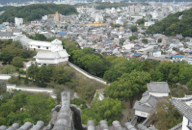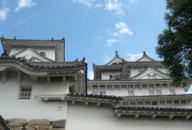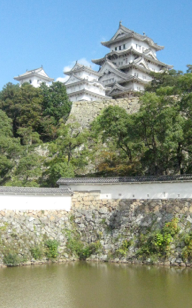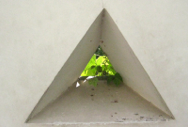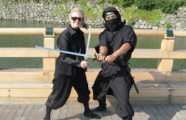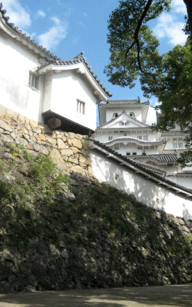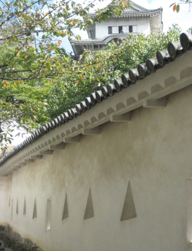himeji castle
island of Honshu
KANSAI REGION, HYOGO prefecture
Japan
October 20, 2007


himeji castle
island of Honshu
KANSAI REGION, HYOGO prefecture
Japan
October 20, 2007




Himeji-Jo Koen, or Himeji Castle is the magnet which drew Henry and me to the small city of Himeji, just an hour by train from Osaka in Western Honshu. The largest and most visited castle in Japan, Himeji Castle is a UNESCO World Heritage Site and is one of twelve remaining feudal castles in Japan. Of these, Himeji Castle is designated a National Treasure, and is considered one of Japan’s premier castles along with Matsumoto Castle and Kumamoto Castle. It was Begun in 1333 as a fort, built on Himeyama Hill, then dismantled in 1346 and rebuilt two centuries later as Himeji Castle, completed with its five story donijon in 1618. In 1600, the castle was awarded to Ikeda Terumasa, son-in-law of Ieyasu Takagawa, for his help in winning the Battle of Sekigahara. Beginning in 1749, the castle was occupied by Sakai Tadasumi and his descendants until the Meiji Restoration in 1867. Regarded as the finest example of 17th century Japanese castle architecture, Himeji Castle was built to withstand invasions. The castle has three moats, plus a confusing labyrinth of buildings within the castle keep, which successfully deterred anyone from scaling the fortress walls. The nickname for this castle is Shiragasi-Jo or ”White Egret”, named for the white plastered walls that are reminiscent of the outstretched wings of an egret in flight. The architectural details are simple and elegant. Thick walls with slate-colored roof tiles line the perimeter of the castle and the inner courtyards. These walls have openings cut in the shape of circles, triangles and rectangles providing access for defense by archers. The drainage alongside the stone walkways consists of the same curved slate-colored tiles laid on end to form a graceful pattern, trimmed in the same curvilinear scalloped shape of the tiles. The roof line of the building alternates between the Chinese arched gables and dormer gables to give a graceful, rhythmic, undulation to the overall pattern of the building. Tips of the roof are called shachi-gawara, the name of a fish-like mythical beast believed to be protective against fire. This obviously worked, because, unlike Osaka-Jo Koen, this castle has never been burned by fire or lightning*. Every oni-gawara “devil tile” or maru-gawara “circle tile” used on the eaves has a family crest of the lords who built or repaired the castle. The stone foundations of the castle and its retaining walls are fan-shaped stonework that makes scaling the walls difficult, if not impossible. Inside the buildings are thick beams, wooden floors with wide boards, and steep, narrow wooden stairways that connect each level. Five stories are evident from the exterior of the building, however six floors actually exist. The second level from the top is divided into two floors. Each floor has hooks for armaments, either long musket-type pistols, introduced by the Portuguese, or spears. Above these are wooden pegs that hold leather bags of gunpowder. On the top level is an expansive view of Himeji and the surrounding mountains. On this level is a small, freestanding, Buddhist shrine, a recent addition, complete with sake bottles, shrine ink stamp and offering box. Visitors are apt to make a wish or say a prayer when they have succeeded their quest to the summit of this great castle.
*Note: For over 400 years, Himeji Castle has remained intact, throughout the extensive bombings of Himeji during World War II, and through natural disasters such as the Great Hanshiin Earthquake of 1995.
PHOTOS: Left Column: 1. Detail of the castle roof with shachi-gawara ornament on the upper roof. 2. Detail: Family Crest ,Tile of Lords. 3. The impressive 17th century Japanese architecture stacks 83 buildings within Himeji Castle’s compound. 4. View of the rooflines of Himeji Castle on an impressive climb skyward. 5. On the Bridge leading to the castle, Jourdan as Ninja with an actual Ninja, mock-fighting with a plastic sword while wearing her normal travel clothes, Issey Miyake Pleats Please. The Ninja is in his uniform with a real sword! Center, Top: View of Himeji Castle, revealing the rooflines that inspired the nickname., “White Egret”. Center, Bottom: Himeji Castle as seen from the fan shaped walls at the level of the moat. Right Column: 1. View from the topmost tower of Himeji Castle over the city of Himeji. 2. The castle as seen from the opposite side of the moat. 3. A defensive opening in the wall. Each is a geometric shape. 4. White painted and pierced walls capped with roof tiles.


Shiragasi-Jo / White Egret
